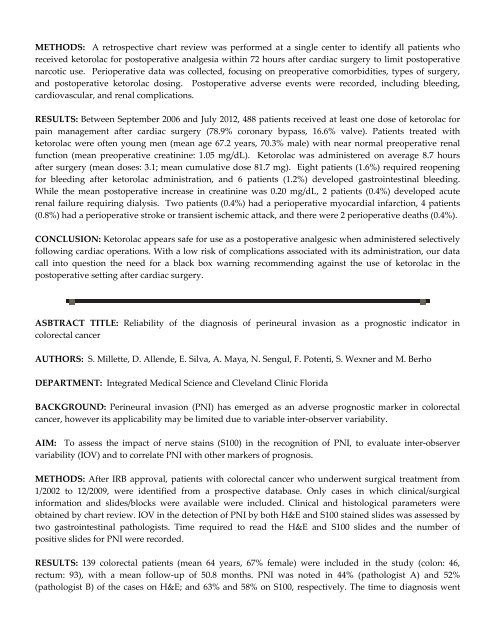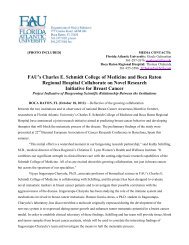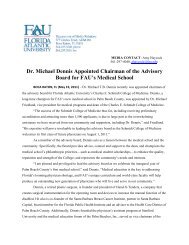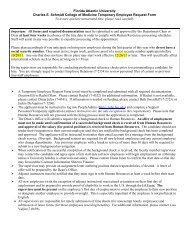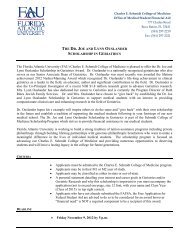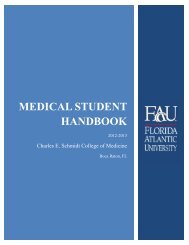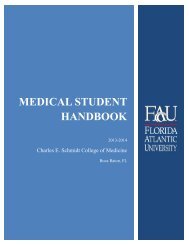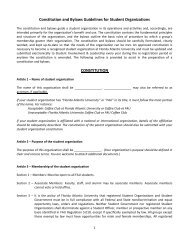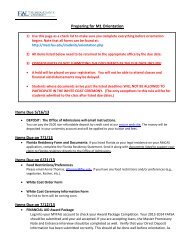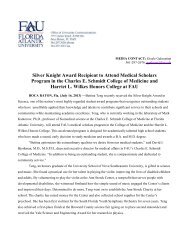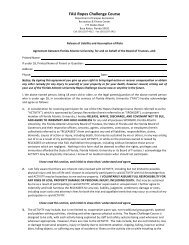Research Day Book 2013 - College of Medicine - Florida Atlantic ...
Research Day Book 2013 - College of Medicine - Florida Atlantic ...
Research Day Book 2013 - College of Medicine - Florida Atlantic ...
You also want an ePaper? Increase the reach of your titles
YUMPU automatically turns print PDFs into web optimized ePapers that Google loves.
METHODS: A retrospective chart review was performed at a single center to identify all patients who<br />
received ketorolac for postoperative analgesia within 72 hours after cardiac surgery to limit postoperative<br />
narcotic use. Perioperative data was collected, focusing on preoperative comorbidities, types <strong>of</strong> surgery,<br />
and postoperative ketorolac dosing. Postoperative adverse events were recorded, including bleeding,<br />
cardiovascular, and renal complications.<br />
RESULTS: Between September 2006 and July 2012, 488 patients received at least one dose <strong>of</strong> ketorolac for<br />
pain management after cardiac surgery (78.9% coronary bypass, 16.6% valve). Patients treated with<br />
ketorolac were <strong>of</strong>ten young men (mean age 67.2 years, 70.3% male) with near normal preoperative renal<br />
function (mean preoperative creatinine: 1.05 mg/dL). Ketorolac was administered on average 8.7 hours<br />
after surgery (mean doses: 3.1; mean cumulative dose 81.7 mg). Eight patients (1.6%) required reopening<br />
for bleeding after ketorolac administration, and 6 patients (1.2%) developed gastrointestinal bleeding.<br />
While the mean postoperative increase in creatinine was 0.20 mg/dL, 2 patients (0.4%) developed acute<br />
renal failure requiring dialysis. Two patients (0.4%) had a perioperative myocardial infarction, 4 patients<br />
(0.8%) had a perioperative stroke or transient ischemic attack, and there were 2 perioperative deaths (0.4%).<br />
CONCLUSION: Ketorolac appears safe for use as a postoperative analgesic when administered selectively<br />
following cardiac operations. With a low risk <strong>of</strong> complications associated with its administration, our data<br />
call into question the need for a black box warning recommending against the use <strong>of</strong> ketorolac in the<br />
postoperative setting after cardiac surgery.<br />
ASBTRACT TITLE: Reliability <strong>of</strong> the diagnosis <strong>of</strong> perineural invasion as a prognostic indicator in<br />
colorectal cancer<br />
AUTHORS: S. Millette, D. Allende, E. Silva, A. Maya, N. Sengul, F. Potenti, S. Wexner and M. Berho<br />
DEPARTMENT: Integrated Medical Science and Cleveland Clinic <strong>Florida</strong><br />
BACKGROUND: Perineural invasion (PNI) has emerged as an adverse prognostic marker in colorectal<br />
cancer, however its applicability may be limited due to variable inter‐observer variability.<br />
AIM: To assess the impact <strong>of</strong> nerve stains (S100) in the recognition <strong>of</strong> PNI, to evaluate inter‐observer<br />
variability (IOV) and to correlate PNI with other markers <strong>of</strong> prognosis.<br />
METHODS: After IRB approval, patients with colorectal cancer who underwent surgical treatment from<br />
1/2002 to 12/2009, were identified from a prospective database. Only cases in which clinical/surgical<br />
information and slides/blocks were available were included. Clinical and histological parameters were<br />
obtained by chart review. IOV in the detection <strong>of</strong> PNI by both H&E and S100 stained slides was assessed by<br />
two gastrointestinal pathologists. Time required to read the H&E and S100 slides and the number <strong>of</strong><br />
positive slides for PNI were recorded.<br />
RESULTS: 139 colorectal patients (mean 64 years, 67% female) were included in the study (colon: 46,<br />
rectum: 93), with a mean follow‐up <strong>of</strong> 50.8 months. PNI was noted in 44% (pathologist A) and 52%<br />
(pathologist B) <strong>of</strong> the cases on H&E; and 63% and 58% on S100, respectively. The time to diagnosis went


